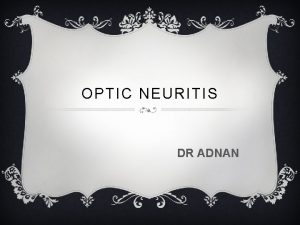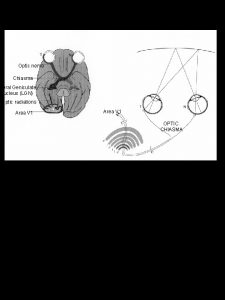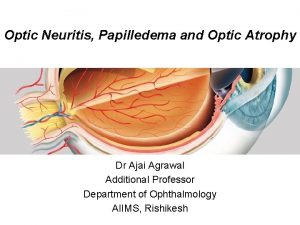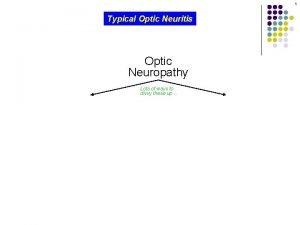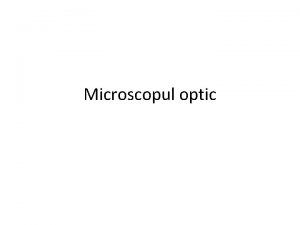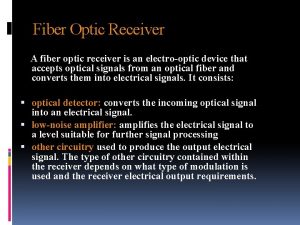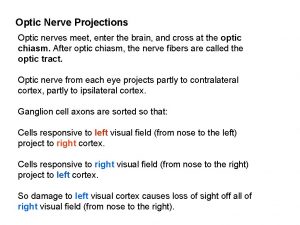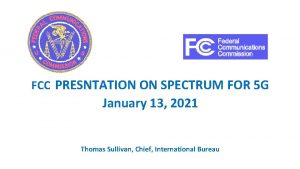In The Name of God CASE PRESNTATION OPTIC





























- Slides: 29

In The Name of God

CASE PRESNTATION OPTIC NEUROPATHY WITH PROGRESSIVE MYELOPATHY Loghman Hospital Y. KHOLGHI MD

HISTORY Ø Ø Ø A 51 years old married right handed female that was in good health until 11 years PTA. She has history of lower limbs heaviness in combination with feeling of coldness in 11 years PTA, that persist 1 -2 month and then subside without any treatment. After 1 year she had complain of visual loss in right eye and then 3 -4 month later in left eye with visual acuity of complete visual loss in right and 6/10 in left eye. Each of visual attacks treated with Methylprednisolone pulse and oral Prednisolone after it, that lead to complete recovery. Concurrent with visual attacks she had sensory complain as coldness and tingling with feeling of heaviness in lower limbs that persists in subsequent 4 years in the spite of normal living activities. She had not any urinary complains in 5 years duration.

HISTORY Ø Ø Ø Since 6 years PTA, she has history of progressive stiffness and weakness in lower limbs with involvement of hands as tingling and heaviness after 2 -3 years, that lead to inability to walking without assistance and loss of dexterity in hands in recent 1 -2 months respectively. She has history of fatigue, frequency, urge incontinence and prolonged constipations since 6 years PTA. Review of Lhermitte’s sign, diplopia, vertigo, unsteady gait, abnormal speech, difficulty swallowing, and other systems was unremarkable (no joints pain and skin lesions). She was under treatment of interferon in 2 subsequent years that discontinue it since 2 years PTA. She is under treatment of Amantadine, Baclofen, Asentra, Alprazolam for reliving stiffness, fatigue and anxiety. She previously treated with MTX.

Positive finding in N/E Ø Norma reaction of both pupils to light. Ø Normal visual acuity. Ø Mild pallor of optic disk in both eyes. Ø Spastic quadriparesia preferentially (with all signs), loss of abdominal reflex, and muscle force of 4/5+ in lower limbs with flexion deformity of ankles in rest position. Ø A sensory level at T 7 -T 8 with abnormal deep sensation in lower limbs. Ø Ability to walking without assistance (up to 10 m).

Abstract of History and N/E Ø A 51 years old married right handed female with history of visual blurring, progressive weakness and stiffness of lower limbs, fatigue, frequency, incontinence and constipation since 11 years PTA. Ø She has bilateral optic disk changes, spastic quadriparesia, a sensory level at T 8 -T 9 and abnormal deep sensation of lower limbs in N/E.

Localization Ø With a normal cranial exam, causing lesion of spastic quadriparesia is in cervical region. Ø But with visual loss in different time, she has a additional localization sign for correct diagnosis as multiple lesions in multiple sites with dissemination in times.

Differential Diagnosis Ø Toxic and metabolic diseases. Ø Degenerative diseases. Ø Tumor and mass lesions. Ø Infectious diseases. Ø Vascular diseases. Ø Demyelinating diseases.

Toxic and metabolic diseases Ø Drugs (Cisplatin, Heroin abuse and rarely Cocaine use). Ø Toxin (Conzo and lathyrism). Ø Metabolic ( Vitamin B 12 deficiency, Mercury intoxication, Alcohol/tobacco amblyopia Central pontine myelinolysis, Marchiafava. Bignami syndrome).

Degenerative Diseases Ø PLS. Ø HSP. Ø SCD. Ø Hereditary disorders of myelin metabolism (ALD, MLD, Krabbe's). Ø Arnold- Chiari malformation.

Tumor and Mass lesions Ø Spinal cord mass lesion: l Intramedullary l Extramedullary Ø Craniocervical junction tumor. Ø Paraneoplastic encephalomyelopathies.

Infectious Diseases Ø HTLV I & II Ø LYME Ø SYPHILIS Ø HIV Ø TB

Vascular Diseases Ø Arteriovenous Malformations. Ø Cavernous Angiomas. Ø Isolated CNS Vasculitis. Ø Collagen Vascular Diseases. Ø Stroke.

Inflammatory Demyelinating Diseases Ø Acute Disseminated Encephalomyelitis. Ø VARIANTS OF MULTIPLE SCLEROSIS. 1. 3. Recurrent Optic Neuropathy Devic's Disease (Neuromyelitis Optica) Slowly Progressive Myelopathy Ø Multiple Sclerosis (PPMS OR SPMS). 2.

Recurrent Optic Neuropathy Ø Ø Ø There are patients whose entire clinical illness is confined to the optic nerves. They may have sequential affection of one nerve, then the other, or they may have simultaneous bilateral vision loss, a state that is quite uncommon in classic MS. Children and preadolescent patients are more likely than adults to have recurrent or simultaneous optic neuropathy. Rarely there is slowly progressive optic neuropathy, similar to that seen with optic nerve sheath tumors, such as meningioma. In bilateral ON, sarcoidosis is commonly a diagnostic consideration.

Devic's Disease (Neuromyelitis Optica) A combination of bilateral optic neuropathy and cervical myelopathy make up this condition. Ø Reported cases indicate that the myelopathy tends to be more severe, with less likelihood of recovery. Ø In some patients the optic neuropathy and the myelopathy occur at the same time, in others one or the other component is delayed (days to weeks). Ø The longer the interval, the more like typical MS is the pathology and better prognosis. Ø

Devic's Disease (Neuromyelitis Optica) Ø Because the optic nerve and the cervical spinal cord are two of the locations in the nervous system in which the lesions of MS are typically found, many patients could be classified as having Devic's disease, or syndrome.

Devic's Disease (Neuromyelitis Optica) Devic's like syndrome can be a manifestation of ADEM or rarely of other autoimmune disease, such as SLE or APAS. Ø This seems to be especially true of patients with relapsing Devic's syndrome, making up approximately one half the patients. Ø In a few patients the distinction between an MS variant and SLE (so-called lupoid sclerosis) is essentially impossible to make, and some of these are patients with neuromyelitis optica. Ø

How differentiate Devic’s from MS Failure to develop Brainstem, Cerebellar or Cerebral demyelinative manifestations. Ø Normality of the cerebral white matter on MRI. Ø Almost uniform absence of OCB and abnormality of Ig. G in CSF. Ø Necrotizing and cavitary nature of spinal cord lesions, affecting gray and white matter. Ø Humoral nature of Devic’s with high titer of antibody in blood in new studies. Ø

Slowly Progressive Myelopathy If there are no sensory signs or symptoms, the entity known as primary lateral sclerosis, one of the group of motor neuron diseases, may be the cause. Ø HTLV-l infection, vitamin B 12 deficiency, and human immunodeficiency virus infection all can be excluded by appropriate testing. Ø Spinal dural arteriovenous fistula can cause a steadily or stepwise progressive myelopathy, usually in the lower spinal segments. Ø Adrenomyeloneuropathy should be considered. Ø

Slowly Progressive Myelopathy Ø A number of patients their spinal MRI results are repeatedly negative. Ø VERs, CSF OCBs, and MRI of the head show no sign of demyelination elsewhere.

Slowly Progressive Myelopathy Some clues that MS is present are Lhermitte's sign, sensitivity to elevated temperature and optic neuritis. Ø

Primary progressive MS Ø Progressive myelopathy caused by MS is part of the primary progressive MS group and carries the poor prognosis typical of that group.

Final Diagnosis Progressive Myelopathy caused by MS (secondary progressive MS)


Ø Ø Ø The degree of compression of the cervical cord by intervertebral disc disease is often an issue in the middle-aged patient, because a majority of persons have some degree of disc disease, and following trauma there may be a T 2 bright signal within the cord due to contusion. There is little doubt that some laminectomies have been carried out for cervical spondylosis where MS was the final correct diagnosis. . The choice of therapy is difficult. Some patients do better for a time with monthly intravenous corticosteroid therapy.

Ø Ø Ø Ø Ø Ø Ø Inflammatory diseases Granulomatous angiitis Systemic lupus erythematosus Sjogren's disease Beh. ; : et's disease Polyarteritis nodosa Paraneoplastic encephalomyelopathies Acute disseminated encephalomyelitis, postinfectious encephalomyelitis Infectious diseases Lyme neuroborreliosis Human T-celllymphotropic virus type I infection': ' Human immunodeficiency virus infection Progressive multifocalleukoencephalopathy': ' Neurosyphilis" Granulomatous diseases Sarcoidosis Wegener's granulomatosis Lymphomatoid granulomatosis Diseases of myelin Metachromatic leukodystrophy (juvenile and adult)': ' Adrenomye Ioleukodystroph y. : . Miscellaneous Spinocerebellar disorders': ' Arnold-Chiari malformation Vitamin Bl 2 deficiency"

Ø Ø Ø Ø Ø Ø Ø Autoimmune Acute disseminated encephalomyelitis Acute hemorrhagic leukoencephalopathy Multiple sclerosis Infectious Progressive multifocalleukoencephalopathy Toxic/metabolic Carbon monoxide Vitamin B 12 deficiency Mercury intoxication (Minamata disease) Alcohol/tobacco amblyopia Central pontine myelinolysis Marchiafava-Bignami syndrome Hypoxia Radiation Vascular Binswanger's disease Hereditary disorders of myelin metabolism Adrenoleukodystrophy Metachromatic leukodystrophy Krabbe's disease Alexander's disease Canavan-van Bogaert-Bertrand disease Pelizaeus-Merzbacher disease Phenylketonuria Multiple sclerosis

(e. g. , vitamin B 12 deficiency, compressive spinal cord lesions, arteriovenous malformations, Ø cavernous angiomas, Arnold-Chiari malformation), infectious Ø causes (syphilis, HTL V-I, human immunodeficiency Ø virus), or hereditary disorders (adult metachromatic leukodystrophy, Ø adrenomyeloleukodystrophy, spinocerebellar Ø disorders). Ø Ø
 Best worst and average case
Best worst and average case Name all rays
Name all rays Hát kết hợp bộ gõ cơ thể
Hát kết hợp bộ gõ cơ thể Bổ thể
Bổ thể Tỉ lệ cơ thể trẻ em
Tỉ lệ cơ thể trẻ em Gấu đi như thế nào
Gấu đi như thế nào Tư thế worms-breton
Tư thế worms-breton Hát lên người ơi
Hát lên người ơi Các môn thể thao bắt đầu bằng tiếng nhảy
Các môn thể thao bắt đầu bằng tiếng nhảy Thế nào là hệ số cao nhất
Thế nào là hệ số cao nhất Các châu lục và đại dương trên thế giới
Các châu lục và đại dương trên thế giới Cong thức tính động năng
Cong thức tính động năng Trời xanh đây là của chúng ta thể thơ
Trời xanh đây là của chúng ta thể thơ Mật thư anh em như thể tay chân
Mật thư anh em như thể tay chân Làm thế nào để 102-1=99
Làm thế nào để 102-1=99 độ dài liên kết
độ dài liên kết Các châu lục và đại dương trên thế giới
Các châu lục và đại dương trên thế giới Thể thơ truyền thống
Thể thơ truyền thống Quá trình desamine hóa có thể tạo ra
Quá trình desamine hóa có thể tạo ra Một số thể thơ truyền thống
Một số thể thơ truyền thống Cái miệng nó xinh thế
Cái miệng nó xinh thế Vẽ hình chiếu vuông góc của vật thể sau
Vẽ hình chiếu vuông góc của vật thể sau Biện pháp chống mỏi cơ
Biện pháp chống mỏi cơ đặc điểm cơ thể của người tối cổ
đặc điểm cơ thể của người tối cổ Thứ tự các dấu thăng giáng ở hóa biểu
Thứ tự các dấu thăng giáng ở hóa biểu Vẽ hình chiếu đứng bằng cạnh của vật thể
Vẽ hình chiếu đứng bằng cạnh của vật thể Tia chieu sa te
Tia chieu sa te Thẻ vin
Thẻ vin đại từ thay thế
đại từ thay thế





























